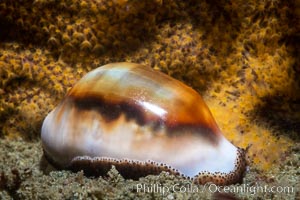
Chestnut cowrie with mantle withdrawn, in front of golden gorgonian.
Species: Chestnut Cowrie, Date Cowrie, Cypraea spadicea
Location: San Diego, California
Image ID: 37289
Species: Chestnut Cowrie, Date Cowrie, Cypraea spadicea
Location: San Diego, California
Image ID: 37289
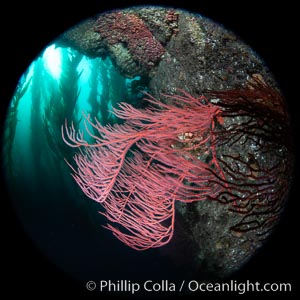
Red gorgonian Leptogorgia chilensis, Catalina Island.
Species: Red gorgonian, Leptogorgia chilensis, Lophogorgia chilensis
Location: Catalina Island, California
Image ID: 37295
Species: Red gorgonian, Leptogorgia chilensis, Lophogorgia chilensis
Location: Catalina Island, California
Image ID: 37295
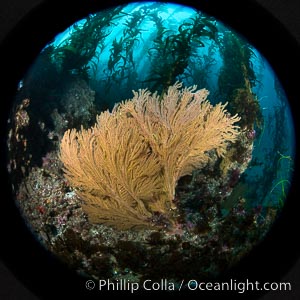
Garibaldi and California golden gorgonian on underwater rocky reef, San Clemente Island. The golden gorgonian is a filter-feeding temperate colonial species that lives on the rocky bottom at depths between 50 to 200 feet deep. Each individual polyp is a distinct animal, together they secrete calcium that forms the structure of the colony. Gorgonians are oriented at right angles to prevailing water currents to capture plankton drifting by.
Species: California golden gorgonian, Giant kelp, Muricea californica, Macrocystis pyrifera
Location: San Clemente Island, California
Image ID: 38501
Species: California golden gorgonian, Giant kelp, Muricea californica, Macrocystis pyrifera
Location: San Clemente Island, California
Image ID: 38501
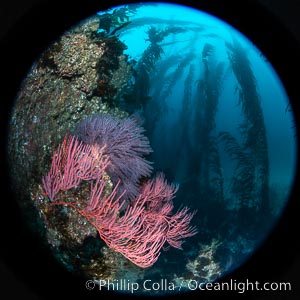
Red gorgonian on rocky reef, below kelp forest, underwater. The red gorgonian is a filter-feeding temperate colonial species that lives on the rocky bottom at depths between 50 to 200 feet deep. Gorgonians are typically oriented at right angles to prevailing water currents to capture plankton drifting by.
Species: Red gorgonian, Giant kelp, Brown gorgonian, Leptogorgia chilensis, Lophogorgia chilensis, Macrocystis pyrifera, Muricea fruticosa
Location: San Clemente Island, California
Image ID: 38502
Species: Red gorgonian, Giant kelp, Brown gorgonian, Leptogorgia chilensis, Lophogorgia chilensis, Macrocystis pyrifera, Muricea fruticosa
Location: San Clemente Island, California
Image ID: 38502
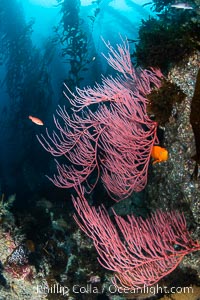
Red gorgonian on rocky reef, below kelp forest, underwater. The red gorgonian is a filter-feeding temperate colonial species that lives on the rocky bottom at depths between 50 to 200 feet deep. Gorgonians are typically oriented at right angles to prevailing water currents to capture plankton drifting by.
Species: Red gorgonian, Giant kelp, Leptogorgia chilensis, Lophogorgia chilensis, Macrocystis pyrifera
Location: San Clemente Island, California
Image ID: 38503
Species: Red gorgonian, Giant kelp, Leptogorgia chilensis, Lophogorgia chilensis, Macrocystis pyrifera
Location: San Clemente Island, California
Image ID: 38503
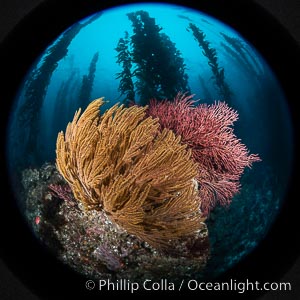
Garibaldi and California golden gorgonian on underwater rocky reef, San Clemente Island. The golden gorgonian is a filter-feeding temperate colonial species that lives on the rocky bottom at depths between 50 to 200 feet deep. Each individual polyp is a distinct animal, together they secrete calcium that forms the structure of the colony. Gorgonians are oriented at right angles to prevailing water currents to capture plankton drifting by.
Species: California golden gorgonian, Giant kelp, Muricea californica, Macrocystis pyrifera
Location: San Clemente Island, California
Image ID: 38504
Species: California golden gorgonian, Giant kelp, Muricea californica, Macrocystis pyrifera
Location: San Clemente Island, California
Image ID: 38504
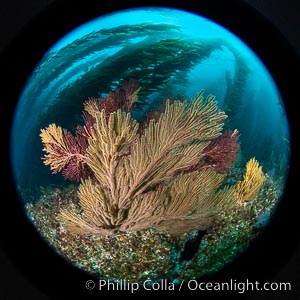
Garibaldi and California golden gorgonian on underwater rocky reef, San Clemente Island. The golden gorgonian is a filter-feeding temperate colonial species that lives on the rocky bottom at depths between 50 to 200 feet deep. Each individual polyp is a distinct animal, together they secrete calcium that forms the structure of the colony. Gorgonians are oriented at right angles to prevailing water currents to capture plankton drifting by.
Species: California golden gorgonian, Giant kelp, Muricea californica, Macrocystis pyrifera
Location: San Clemente Island, California
Image ID: 38509
Species: California golden gorgonian, Giant kelp, Muricea californica, Macrocystis pyrifera
Location: San Clemente Island, California
Image ID: 38509
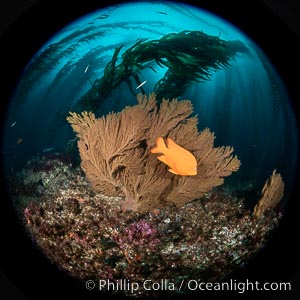
Garibaldi and California golden gorgonian on underwater rocky reef, San Clemente Island. The golden gorgonian is a filter-feeding temperate colonial species that lives on the rocky bottom at depths between 50 to 200 feet deep. Each individual polyp is a distinct animal, together they secrete calcium that forms the structure of the colony. Gorgonians are oriented at right angles to prevailing water currents to capture plankton drifting by.
Species: California golden gorgonian, Giant kelp, Garibaldi, Muricea californica, Macrocystis pyrifera, Hypsypops rubicundus
Location: San Clemente Island, California
Image ID: 38510
Species: California golden gorgonian, Giant kelp, Garibaldi, Muricea californica, Macrocystis pyrifera, Hypsypops rubicundus
Location: San Clemente Island, California
Image ID: 38510
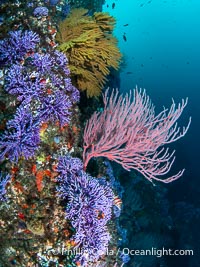
Red gorgonian Leptogorgia chilensis, purple hydrocoral Stylaster californicus, and yellow zoanthid anemone Epizoanthus giveni, at Farnsworth Banks, Catalina Island.
Location: Catalina Island, California
Image ID: 39539
Location: Catalina Island, California
Image ID: 39539
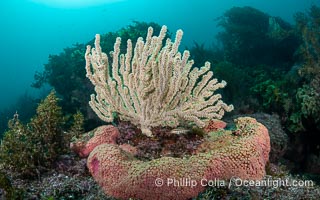
Pink Sponges Encrusting Rocky Reef alongside various species of algae and gorgonians, San Pedro Martir Island, Sea of Cortez.
Location: Isla San Pedro Martir, Sonora, Mexico
Image ID: 40374
Location: Isla San Pedro Martir, Sonora, Mexico
Image ID: 40374
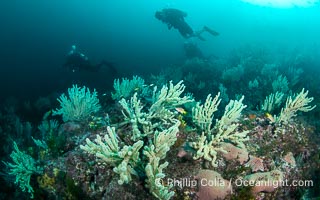
Gorgonians on Lush Rocky Reef, San Pedro Martir Island, Sea of Cortez. Gorgonians are colonial filter feeders, spreading their branches into the currents flowing over the reef in order to gather passing bits of food.
Location: Isla San Pedro Martir, Sonora, Mexico
Image ID: 40408
Location: Isla San Pedro Martir, Sonora, Mexico
Image ID: 40408
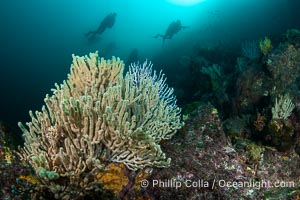
Gorgonians on Lush Rocky Reef, San Pedro Martir Island, Sea of Cortez. Gorgonians are colonial filter feeders, spreading their branches into the currents flowing over the reef in order to gather passing bits of food.
Location: Isla San Pedro Martir, Sonora, Mexico
Image ID: 40415
Location: Isla San Pedro Martir, Sonora, Mexico
Image ID: 40415
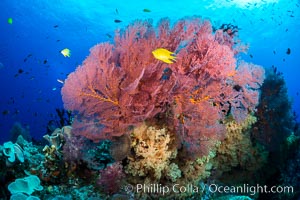
Sea fan or gorgonian on coral reef. This gorgonian is a type of colonial alcyonacea soft coral that filters plankton from passing ocean currents.
Species: Dendronephthya soft coral, Gorgonian, Dendronephthya, Gorgonacea
Location: Vatu I Ra Passage, Bligh Waters, Viti Levu Island, Fiji
Image ID: 31343
Species: Dendronephthya soft coral, Gorgonian, Dendronephthya, Gorgonacea
Location: Vatu I Ra Passage, Bligh Waters, Viti Levu Island, Fiji
Image ID: 31343
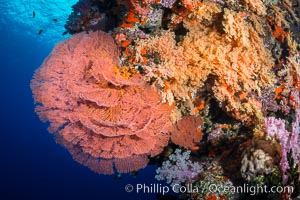
Plexauridae sea fan or gorgonian on coral reef. This gorgonian is a type of colonial alcyonacea soft coral that filters plankton from passing ocean currents.
Species: Dendronephthya soft coral, Gorgonian, Sea fan, Dendronephthya, Gorgonacea, Plexauridae
Location: Vatu I Ra Passage, Bligh Waters, Viti Levu Island, Fiji
Image ID: 31344
Species: Dendronephthya soft coral, Gorgonian, Sea fan, Dendronephthya, Gorgonacea, Plexauridae
Location: Vatu I Ra Passage, Bligh Waters, Viti Levu Island, Fiji
Image ID: 31344
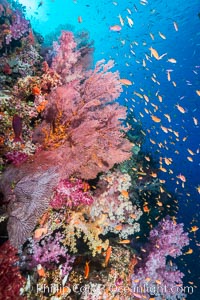
Colorful Dendronephthya soft corals and red gorgonian and schooling Anthias fish on coral reef, Fiji.
Species: Anthias, Dendronephthya soft coral, Gorgonian, Dendronephthya, Gorgonacea, Pseudanthias
Location: Vatu I Ra Passage, Bligh Waters, Viti Levu Island, Fiji
Image ID: 31351
Species: Anthias, Dendronephthya soft coral, Gorgonian, Dendronephthya, Gorgonacea, Pseudanthias
Location: Vatu I Ra Passage, Bligh Waters, Viti Levu Island, Fiji
Image ID: 31351
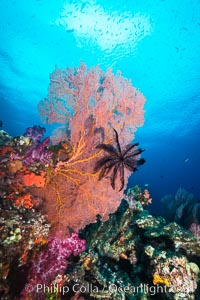
Crinoid clinging to gorgonian sea fan, Fiji.
Species: Crinoid feather star, Gorgonian, Crinoidea, Gorgonacea
Location: Vatu I Ra Passage, Bligh Waters, Viti Levu Island, Fiji
Image ID: 31355
Species: Crinoid feather star, Gorgonian, Crinoidea, Gorgonacea
Location: Vatu I Ra Passage, Bligh Waters, Viti Levu Island, Fiji
Image ID: 31355
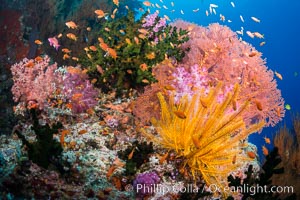
Spectacular pristine tropical reef with vibrant colorful soft corals. Dendronephthya soft corals, crinoids, sea fan gorgonians and schooling Anthias fishes, pulsing with life in a strong current over a pristine coral reef. Fiji is known as the soft coral capitlal of the world.
Species: Anthias, Black sun coral, Crinoid feather star, Dendronephthya soft coral, Gorgonian, Crinoidea, Dendronephthya, Gorgonacea, Pseudanthias, Tubastrea micrantha
Location: Vatu I Ra Passage, Bligh Waters, Viti Levu Island, Fiji
Image ID: 31363
Species: Anthias, Black sun coral, Crinoid feather star, Dendronephthya soft coral, Gorgonian, Crinoidea, Dendronephthya, Gorgonacea, Pseudanthias, Tubastrea micrantha
Location: Vatu I Ra Passage, Bligh Waters, Viti Levu Island, Fiji
Image ID: 31363
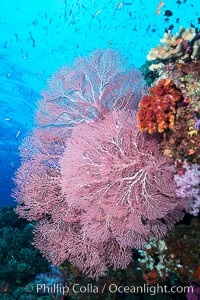
Plexauridae sea fan or gorgonian on coral reef. This gorgonian is a type of colonial alcyonacea soft coral that filters plankton from passing ocean currents.
Species: Gorgonian, Sea fan, Gorgonacea, Plexauridae
Location: Namena Marine Reserve, Namena Island, Fiji
Image ID: 31364
Species: Gorgonian, Sea fan, Gorgonacea, Plexauridae
Location: Namena Marine Reserve, Namena Island, Fiji
Image ID: 31364
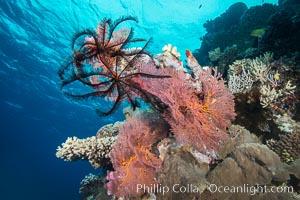
Crinoid clinging to gorgonian sea fan, Mount Mutiny, Bligh Waters, Fiji.
Species: Crinoid feather star, Gorgonian, Crinoidea, Gorgonacea
Location: Vatu I Ra Passage, Bligh Waters, Viti Levu Island, Fiji
Image ID: 31368
Species: Crinoid feather star, Gorgonian, Crinoidea, Gorgonacea
Location: Vatu I Ra Passage, Bligh Waters, Viti Levu Island, Fiji
Image ID: 31368
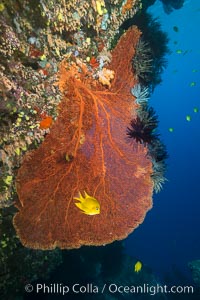
Gorgonian Sea Fan on Coral Reef, Fiji.
Species: Crinoid feather star, Gorgonian, Crinoidea, Gorgonacea
Location: Vatu I Ra Passage, Bligh Waters, Viti Levu Island, Fiji
Image ID: 31373
Species: Crinoid feather star, Gorgonian, Crinoidea, Gorgonacea
Location: Vatu I Ra Passage, Bligh Waters, Viti Levu Island, Fiji
Image ID: 31373
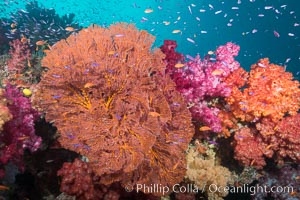
Beautiful South Pacific coral reef, with gorgonian sea fans, schooling anthias fish and colorful dendronephthya soft corals, Fiji.
Species: Anthias, Dendronephthya soft coral, Gorgonian, Dendronephthya, Gorgonacea, Pseudanthias
Location: Gau Island, Lomaiviti Archipelago, Fiji
Image ID: 31381
Species: Anthias, Dendronephthya soft coral, Gorgonian, Dendronephthya, Gorgonacea, Pseudanthias
Location: Gau Island, Lomaiviti Archipelago, Fiji
Image ID: 31381
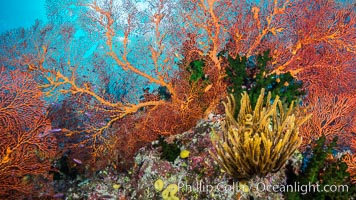
Red Gorgonian and Yellow Crinoid on Coral Reef, Fiji.
Species: Black sun coral, Crinoid feather star, Gorgonian, Crinoidea, Gorgonacea, Tubastrea micrantha
Location: Wakaya Island, Lomaiviti Archipelago, Fiji
Image ID: 31395
Species: Black sun coral, Crinoid feather star, Gorgonian, Crinoidea, Gorgonacea, Tubastrea micrantha
Location: Wakaya Island, Lomaiviti Archipelago, Fiji
Image ID: 31395
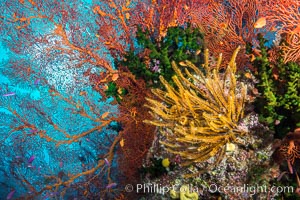
Yellow crinoid, green fan coral and red gorgonian on colorful and pristine coral reef, Fiji.
Species: Black sun coral, Crinoid feather star, Gorgonian, Crinoidea, Gorgonacea, Tubastrea micrantha
Location: Wakaya Island, Lomaiviti Archipelago, Fiji
Image ID: 31396
Species: Black sun coral, Crinoid feather star, Gorgonian, Crinoidea, Gorgonacea, Tubastrea micrantha
Location: Wakaya Island, Lomaiviti Archipelago, Fiji
Image ID: 31396
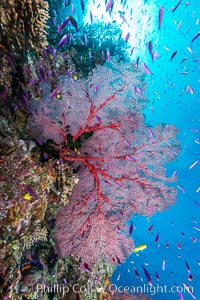
Sea fan gorgonian and schooling Anthias on pristine and beautiful coral reef, Fiji.
Species: Anthias, Gorgonian, Gorgonacea, Pseudanthias
Location: Wakaya Island, Lomaiviti Archipelago, Fiji
Image ID: 31397
Species: Anthias, Gorgonian, Gorgonacea, Pseudanthias
Location: Wakaya Island, Lomaiviti Archipelago, Fiji
Image ID: 31397
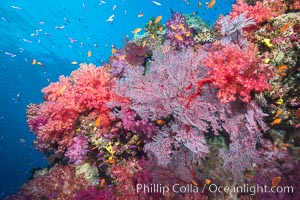
Beautiful tropical reef in Fiji. The reef is covered with dendronephthya soft corals and sea fan gorgonians, with schooling Anthias fishes swimming against a strong current.
Species: Anthias, Dendronephthya soft coral, Gorgonian, Dendronephthya, Gorgonacea, Pseudanthias
Location: Namena Marine Reserve, Namena Island, Fiji
Image ID: 31401
Species: Anthias, Dendronephthya soft coral, Gorgonian, Dendronephthya, Gorgonacea, Pseudanthias
Location: Namena Marine Reserve, Namena Island, Fiji
Image ID: 31401
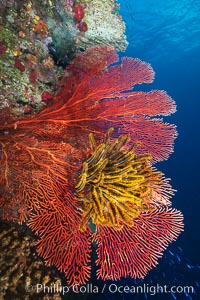
Crinoid clinging to gorgonian sea fan, Fiji.
Species: Crinoid feather star, Gorgonian, Crinoidea, Gorgonacea
Location: Namena Marine Reserve, Namena Island, Fiji
Image ID: 31404
Species: Crinoid feather star, Gorgonian, Crinoidea, Gorgonacea
Location: Namena Marine Reserve, Namena Island, Fiji
Image ID: 31404
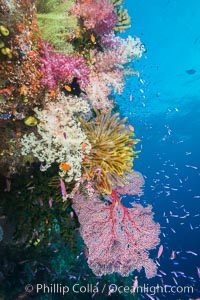
Spectacular pristine tropical reef with vibrant colorful soft corals. Dendronephthya soft corals, crinoids, sea fan gorgonians and schooling Anthias fishes, pulsing with life in a strong current over a pristine coral reef. Fiji is known as the soft coral capitlal of the world.
Species: Anthias, Crinoid feather star, Dendronephthya soft coral, Gorgonian, Crinoidea, Dendronephthya, Gorgonacea, Pseudanthias
Location: Namena Marine Reserve, Namena Island, Fiji
Image ID: 31409
Species: Anthias, Crinoid feather star, Dendronephthya soft coral, Gorgonian, Crinoidea, Dendronephthya, Gorgonacea, Pseudanthias
Location: Namena Marine Reserve, Namena Island, Fiji
Image ID: 31409
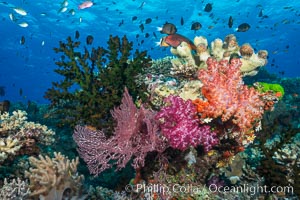
Soft corals (gorgonians, dendronephthya) and hard corals cover a pristine and beautiful south Pacific coral reef, Fiji.
Species: Black sun coral, Dendronephthya soft coral, Gorgonian, Dendronephthya, Gorgonacea, Tubastrea micrantha
Location: Namena Marine Reserve, Namena Island, Fiji
Image ID: 31418
Species: Black sun coral, Dendronephthya soft coral, Gorgonian, Dendronephthya, Gorgonacea, Tubastrea micrantha
Location: Namena Marine Reserve, Namena Island, Fiji
Image ID: 31418
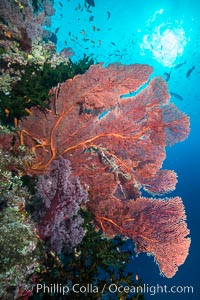
Plexauridae sea fan or gorgonian on coral reef. This gorgonian is a type of colonial alcyonacea soft coral that filters plankton from passing ocean currents.
Species: Gorgonian, Sea fan, Gorgonacea, Plexauridae
Location: Namena Marine Reserve, Namena Island, Fiji
Image ID: 31421
Species: Gorgonian, Sea fan, Gorgonacea, Plexauridae
Location: Namena Marine Reserve, Namena Island, Fiji
Image ID: 31421
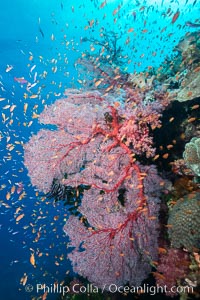
Sea fan gorgonian and schooling Anthias on pristine and beautiful coral reef, Fiji.
Species: Anthias, Gorgonian, Sea fan, Gorgonacea, Plexauridae, Pseudanthias
Location: Fiji
Image ID: 31425
Species: Anthias, Gorgonian, Sea fan, Gorgonacea, Plexauridae, Pseudanthias
Location: Fiji
Image ID: 31425